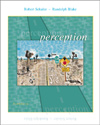| After studying the chapter, the student should be able to...
1.) Discuss what is meant by an object's "form" and the importance
of this concept in understanding visual perception. 2.) Explain what is meant by a "spatial scale" and its relevance
to image analysis. Distinguish between course and fine spatial scale information. 3.) Explain the multichannel model suggested by Campbell and Robson and the
importance of this theory to form perception. 4.) Describe a "grating" and its relevance to visual perception.
Identify and distinguish between the four primary characteristics of a grating
and explain the attributes of each characteristic. 5.) Explain both a transfer function and a Fourier analysis including their
relevant use in the study of form perception. 6.) Distinguish between a transfer function and a contrast sensitivity function
(CSF) and explain why two different terms are employed for similar functions. 7.) Discuss the relationship between photopic, mesopic, and scotopic vision
and contrast sensitivity in regards to the visual system. 8.) Compare and contrast variations in the CSF among species and explain why
these variations may serve adaptive purposes. 9.) Explain the differences between the contrast sensitivity functions of different
age groups throughout the human life span and discuss the problems that can
occur at each age. 10.) Discuss the various ways that pattern vision can be altered as a result
of natural causes or through intentional technique. 11.) Explain the role of texture in the detection and discrimination of forms.
Include in your discussion those aspects of texture thought to have the greatest
influence on form perception. 12.) Discuss the Gestalt movement and explain how this turn of the century
school of thought is relevant to our discussion of spatial vision and form perception.
Relate specific Gestalt principles to the process of vision. | 


 2002 McGraw-Hill Higher Education
2002 McGraw-Hill Higher Education